Alfio Giuffrida
Alfio Giuffrida (born 28 January 1953) is a contemporary Italian sculptor, object and installation artist, set designer and painter. He is one of the artists who consciously refused to bow down to the current trends in order to create a highly distinct, coherent piece of work. Giuffrida who comes from Catania initially worked in Rome until he relocated to Germany in the mid eighties.
Alfio Giuffrida | |
|---|---|
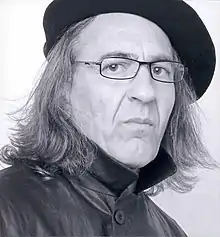 Alfio Giuffrida (2008) | |
| Born | 28 January 1953 Zafferana Etnea, Italy |
| Nationality | Italian |
| Education | Accademia di Belle Arti di Roma |
| Known for | Painting, Sculpture, Scenography |
| Website | AG Sinnwerke® |
During the self-imposed exile in the foreign language environment, he developed his artistic vocabulary with which he formulated his own cosmos. With the Adjustable Elements, Giuffrida bypassed the boundaries of the term “sculpture” known until then. Ambiguity and variability become basic principles which constitute Giuffrida's sculptures as well as his paintings.
Biography

Giuffrida was born in Zafferana Etnea. His relationship to art could be described as scientific, even at a very young age: he applied himself with persistent dedication to drawing, painting and constructing. A scale model reproduction of the church in his home town became a research project lasting years. He kept destroying the work, so that he could start it immediately from scratch again taking lessons from his previous experimentation, applying even greater precision and oriented more closely to reality. The uncompromising striving for perfection, aiming at the best possible expression of his creative visions, would always stay with him in years to come as well.
In his early youthful phase Giuffrida primarily approached nature and man's creative potential in his painting, and these remained a constant reference point in his art in the years ahead. He experimented with the possibilities of painting and collage techniques. His paintings tend to feature calm, predominantly blue spaces, punctuated by white light reflexes that constantly reoccur in his later work. The blister packing he adds to the pictures evokes the image of a computer keyboard, and also looks like a picture taken from space of geographical and city structures, a bird's eye photo of urban landscapes seen through a lunar filter.
A period of intense nature studies followed these works, though he did not formulate them as naturalistic reproductions but instead took them in an abstract direction. With scientific precision, he examined plant structures in particular, dissecting organic material and making cross sections in natural tissue in order to study the essence of things and figure out the basic nature of form. Giuffrida understood the minutiae at the heart of the elements he analysed as fundamental forms of nature, which are combined in natural creation in myriad, endlessly varied formations. He reduces these basic shapes to geometric patterns which he captures in small square pictures in equally diverse variations. These mainly take the form of black-and-white dabbed paintings, some of which are on transparent paper that seems to correspond to the materiality of the diaphanous floral tissue. It is at this point that he begins to be captivated by the technical quality and effect of transparency, another guiding principle running consistently through Giuffrida's art and his constant search for the best forms of expression for the wide range of materials suited to him.
Works
There was a concentrated series of works in the early 1970s influenced by Minimalism (Minimal Art). Among other things, he created transparent, folded canvases that incorporated superimposed folded shapes, form elements – cut out and therefore definitively liberated from their original context: floating particles in a solidified fluid, like scattered inlays in radiant amber. The colour only becomes apparent in the light and iridescence, further differentiated by the surface. As in other still haptic works, the first configurations are not created through construction but through attachments that allow forms to emerge through a mechanical process, almost by chance and in a semi-experimental way. Impression, abrasion, reprinting, reduction are pseudo-objective processes that resemble scientific production methods in the infusion of chance and methodology, subjectivity and objectivity. Pastel colours are dabbed on paper then gently lifted off, their image detached onto gauze impregnated with glue, the colour particles sticking to it like delicate pollen. In the milky-white of the semi-transparent base mass, the detached pigments float like preciously preserved spolia and spores, sprinkled like stars over the universe of the paper. Imperceptibly yet inexorably their blaze expands the sfumato-white background into an all-encompassing space which attains cosmic dimensions and spans light years.
In 1975 he returned to non-figurative representation. This period saw him participating at the X Rome Quadriennale that year.
Between 1977 and 1985 he worked as a freelance painter and set designer in Rome. At this point he began to develop a substantial body of painted work, a stringent transitional route in which the reduction of form revealed his early proximity to Minimalist Art and at the same time took on mythical, fantastic features. His pictorial language incorporates traces of Italian Futurism (Giacomo Balla, Carlo Carrà), of painters such as Lucio Fontana, Mario Nigro, Gustav Klimt, Sonia and Robert Delaunay, Pablo Picasso and Wassily Kandinsky. Added to which, it can also be traced back to Pre-Columbian Mayan art. Experience of post-Impressionism (Pointillism) combines with computer graphics techniques (raster graphics), which in turn have links to the visual effects of his current high-tech constructions (microwave towers).
He moved to Cologne in 1986, deliberately setting his sights on one of the most active centres in contemporary art at that time. The colours appear in characteristic dapple style on large-format canvasses, under which shapes are silhouetted, apparently moving as if behind textured glass. The horizontally layered colours are broken up in irregular though rhythmic sequences, and in this way suggest the movement of an undetected being that is captured in a distortion akin to a wipe effect in photography. Something similar happens in the human images group of works in which figurative representation becomes an experimental sphere. The human images develop their suggestive power through serial sequencing and dynamic distortion. In their mask-like reproduction of almost identical forms, they run counter to any expression of unique personality, which differs from the classical portrait emphasizing one person's individuality. The human being mutates into a prototype, appearing in diverse variations within the serial arrangement and disappearing in the masses.
From 1990 to 2004 he worked in his studio in Bonn. Still committed to varied sequences and rhythmic movement, Giuffrida ended up in his new group of works at the picture puzzle using abstract elements and shapes. Canvasses were now inspired by architectural and ornamental structures captured in mysterious light and shadow arrangements, in shades of grey-blue and white. With the wooden reliefs and sculptures that then followed in 1995, Giuffrida transposed the notion of picture puzzles into the third dimension. He made assemblages from dismantled individual items and furniture freed from its functional context, combining them with worked wood panels. The relief-like wooden sculptures look like magnified details of the painted puzzles. Symmetrical arrangements, repetitions and sequences crop up here as well.
Following his principle of systematically carrying on the experiments he had begun with these expressive tools, Giuffrida used the static wooden reliefs to develop symmetrical yet mobile iron sculptures in similar dimensions, the so-called Elements or Adjustable Sculptures. Giuffrida linked iron strips with multiple joints together in such a way that they could pivot on the joints; the observer consciously becomes a participant in art by being encouraged to alter the sculptures.

From this point the road led to new materials and dimensions. Sculptures made of iron and Perspex represented a new group of works. Initially they were made life-size. Everyday found objects were put on Perspex plinths and became assemblages associated with new meaning. Later they took up so much room that the Perspex bases grew into navigable spaces with corridors and transparent walls, while antenna-like watchmen or signals loomed high above the viewers. Giuffrida increasingly brought his creative drive to the public space. The project The whole world as a sculpture park was conceived and presented in public for the first time in September 1997. A tower made of steel struts about 21 metres high forms the end point of a series of steel sculptures, each of which denotes one of the steps linking the graphic design and the end result of the monument. The structures of the steel sculptures are reminiscent of electricity pylons, bearers and conductors of energy that belong to the absolutely essential nature of the living world, just like art. The ultimate aim of the project is to gradually replace all pylons with new large-scale sculptures designed by artists that are both art works and functional objects.

2003 saw the founding of the fictitious factory A.G. Sinnwerke®. The first products to appear under the A.G. Sinnwerke label were the CDs, CD-Sets, and Selbstbau-Sets. More concentrated object cycles followed: CD-Roms, Samples, Ovali, Kugeln, Irrigatoren, Mona Lisa, and Sample-Sets, all offered in blister packs. Adjustable, space-consuming sculptures were made in parallel, their models presented in the form of corsets. Many ideas were captured in painting. He followed the same principle when he continued the richly varied idea of the objects in painting : Irrigatoren, Irrigatoren-Sätze, CD-Homes, Figuren, Enthüllungen, Bezüge, Seitenblicke, Antennen, Töpfe, Tempel, Angebote, CD-Stapel, Kathedralen etc. Eventually the artist provided only the material, that is, the Do-it-yourself-Baukästen, allowing the buyer to come to a personal decision about what form to use for his or her individual picture.
Exhibitions
Selected exhibitions
March/April 1989 Bahnwärterhaus Villa Merkel – Galerie der Stadt Esslingen. February/April 2001 Suermondt-Ludwig-Museum Aachen. April/June 2001 Stadtmuseum Siegburg. July/August 2004 Mannheimer Kunstverein. September/December 2006 Märkisches Museum Witten. March/June 2007 Stadtmuseum Bergkamen.
Stage design
Alongside his creative work Giuffrida has devoted himself to set design for dance theatre ever since his days in Rome. The stage images he has created are characterized by light, transparency, movement and a lightness of touch. Typical features are large-scale objects without a fixed installation, like steel struts and frames that the dancers can move around in the space: the rhythm and variation of stage set and dance are mutually complementary. This allows the creation of ever-new spatial definitions and flexible images, in which the notion of the relativity of viewer and object through the movement in space or the movement of space itself in turn becomes the theme itself. From 1995 he has been set designer for, among others, Tanzforum Köln, Euregio Tanzforum, and Jochen Ulrich.
Notebook, Premiere, 2 May 1995, Oper der Stadt Köln. Die Verlobung in St. Domingo, 17 June 1995, Schlosserei Schauspiel Köln. Goya-Danzas negras, 20 December 1995, Oper der Stadt Köln. Get up Early, 22 February 1996, Internationales Tanzfestival Wien. Citizen Kane, 4 April 1997, Oper der Stadt Köln. Diaghilew - Die Offenbarung, 10 January 1999, Tiroler Landestheater Innsbruck. Lorca y Dalí-Perros de Luna, 19 February 1999, Stadsschouwburg Heerlen (NL). Mon Orphée, 1 April 2000, Ludwig Forum für Internationale Kunst, Aachen. Phädra, 30 November 2000, Deutsche Oper am Rhein, Düsseldorf. Romeo und Julia, 20 January 2001, Tiroler Landestheater Innsbruck. Casanova, 10 November 2001, Tiroler Landestheater Innsbruck. Diaghilew - Die Favoriten, 8 November 2003, Aalto Theater Essen. Caravaggio, 22 November 2003, Tiroler Landestheater Innsbruck. Sissi - Kaiserliche Hoheit, 22 October 2005, Tiroler Landestheater Innsbruck.
Bibliography
Künstler in Köln 1990, Köln 1989. M. Haas, A. Tolnay (Bearb.), Grafische Sammlung der Stadt Esslingen am Neckar, Bestands-Kat. II, Esslingen 1991. B. Colarossi (Ed.), Quadriennale D′arte di Roma, Inv. Dell′arch., Rome 2000, ISBN 8876211276. Ulrich Schneider, Gert Fischer: Suermondt Ludwig Museum Aachen, Stadtmuseum Siegburg (Hrsg.): Giuffrida, Aachen/Siegburg 2001, ISBN 3-00-007525-9. Martin Stather: A.G. Sinnwerke, Mannheimer Kunstverein (Hrsg.): A.G. Sinnwerke Giuffrida CDs, Bonn 2004, ISBN 3-00-014058-1. Nele Lipp, Uwe Rüth: Skulpturenmuseum Glaskasten Marl (Hrsg.): Körper – Leib – Raum: Der Raum im zeitgenössischen Tanz und in der zeitgenössischen Plastik, Marl 2006, ISBN 3-924790-73-6.
Gallery
 Spiegel-exp9, 2009
Spiegel-exp9, 2009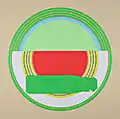 Irrigatoren-exp8, 2006
Irrigatoren-exp8, 2006 Figuren-exp5, 2009
Figuren-exp5, 2009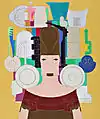 Figuren-exp34, 2009
Figuren-exp34, 2009
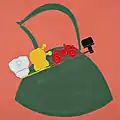 Bezüge-exp4, 2008
Bezüge-exp4, 2008 Bezüge-exp7, 2008
Bezüge-exp7, 2008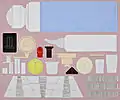 Kathedralen-Do it yourself-Baukaesten-Set1, 2009
Kathedralen-Do it yourself-Baukaesten-Set1, 2009 Kathedralen-exp1, 2009
Kathedralen-exp1, 2009
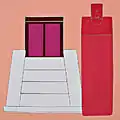 Angebote-exp15, 2008
Angebote-exp15, 2008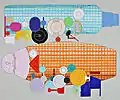 Kathedralen-schwerelos-exp7, 2009
Kathedralen-schwerelos-exp7, 2009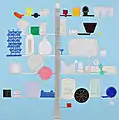 Antennen-exp2, 2009
Antennen-exp2, 2009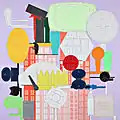 CD-HOMES-exp19, 2008
CD-HOMES-exp19, 2008
See also
References
External links
| Wikimedia Commons has media related to Alfio Giuffrida. |
- a-g-sinnwerke.com
- a-g-sinnwerke.de
- a-g-sinnwerke.eu
- a-g-sinnwerke.net
- www.kulturportal.de/-/kulturschaffende/detail/70421
- www.wienerzeitung.at/nachrichten/english_news/197106_Casanova-in-Tyrol.html
- www.members.aon.at/blindenverband-ktn/theater_info.htm
- www.tanz.at/KRITIK_2003/texte/KRIT_03_71.html
- www.berliner-zeitung.de/archiv/mit--citizen-kane--endet-die-geschichte-des-koelner-tanz-forums-zehn-jahre-zu-spaet,10810590,9272726.html
- www.tanz.at/KRITIK_2005/texte/KRIT_04_196.html
- www.tirol.gv.at/.webloc
- www.landestheater.at/stueck.php?id=163
- www.landestheater-linz.at/8682_DE-Das_Ensemble.-Biographie.htm?persid=1409&archiv=1
- www.landestheater-linz.at/8578_DE-Die_Stuecke.-Stueckinfo.htm?stueckid=166&archiv=1
- www.tanz.at/KRITIK_2008/texte/KRIT_04_441.html
- www.tanznetz.de/koegler.phtml?page=showthread&aid=73&tid=3899
Notes
- X Quadriennale – la nuova generazione. De Luca, 1975
- Artforum-International. March 1987
- Bonner Rundschau – Synthese von Bühnenbild und Malerei. 20 Nov. 1987
- General-Anzeiger/Bonner Stadtanzeiger – Farbe und Licht. 23 Nov. 1987
- Flash Art-International. March–April 1988
- Ruhr-Nachrichten/Dortmunder Zeitung – Sammlerwert haben die Plakate. 21 Dec. 1988
- Westfälische Rundschau/Zeitung für Dortmund – Für die Oper. 21 Dec. 1988
- Esslinger Zeitung – Eine eigene Sprache in Form und Farbe. 10 March 1989
- Esslinger Zeitung – Übersetzung – Im Bahnwärterhaus. 29 March 1989
- Rems-Zeitung / Kultur – Leises Flüstern eines Farben-Magiers – Eine abgemilderte südliche Farbenpracht. 9 Feb. 1991
- Kölnische Rundschau – Wenn Iphigenie in Brooklyn lebt – Premiere des Tanz-Forums: „Notebook“ aus 25 Jahren. 4 Feb. 1995
- F.A.Z. Frankfurter Allgemeine Zeitung – Alle Rassen kriegen ihr Fett weg – Mit der„Verlobung in St. Domingo“ gewinnt das Kölner Tanz-Forum verlorenes Terrain zurück. J. Schmidt, 30 June 1995
- Kölner Stadt-Anzeiger – Dreifach lockt die Herzogin von Alba. 22 Dec. 1995
- Bonner Rundschau / Kultur – Die Phantome des Fegefeuers. 22 Dec. 1995
- NZZ Neue Zürcher Zeitung – Tanz in die (Vogel-)Freiheit – Das Tanz-Forum Koeln mit seiner ersten freien Produktion, „Goya“. 23 Dec. 1995
- Der Standard / Kultur – Bewegte Greuelbilder als Kopfgeburt der Welt – Mit Jochen Ulrichs Kölner „Goya“-Projekt wird „Tanz '96“ eröffnet. 23 Dec. 1995
- F.A.Z. Frankfurter Allgemeine Zeitung – Künstler in der Schreckenswelt – Jochen Ulrichs „Goya“: Die erste freie Produktion des unabhängigen Kölner Tanz-Forums. J. Schmidt, 28 Dec. 1995
- Frankfurter Rundschau – Die Versuchung des Malers – Jochen Ulrich zeigte seine ambitionierte „Goya“-Choreographie im Koelner Tanz-Forum. 28 Dec. 1995
- Der Standard /Kultur – Getanzte Morgenwäsche für Frühaufsteher. 24 Feb. 1996
- F.A.Z. Frankfurter Allgemeine Zeitung – Warum man liebt und wieder damit aufhört – Unternehmungslustige Frühaufsteher: Das Wiener Festival „Tanz '96“ eröffnet mit Jochen Ulrichs „Get Up Early“. J. Schmidt, 1 March 1996
- Ballett-International – Night Birds and Early Risers. J. Schmidt. Issue 4. - April 1996
- Kölner Stadt-Anzeiger – Man springt und kreiselt. 6 May 1997
- Handelsblatt / Kultur – „Citizen Kane“ in Köln. Wille zur Macht. 8 May 1997
- Tanztheater heute: dreissig Jahre deutsche Tanzgeschichte. J. Hinzmann, M. Merschmeier. - Kallmeyer, 1998. ISBN 378000111X
- Tiroler Tageszeitung / Kultur – Die Quellen der Kreativität. 12 Jan. 1999
- F.A.Z. Frankfurter Allgemeine Zeitung – Prometheus brennt – Diaghilew wärmt sich: Ulrichs Innsbrucker Ballett „Offenbarung“. J. Schmidt, 19 Jan. 1999
- NZZ Neue Zürcher Zeitung – Diaghilew-Hommage aus heutigem Geist – Tanztheater im Landestheater Innsbruck. 26 Jan. 1999
- Mittelbayerische Zeitung – „Die ganze Welt ein Skulpturenpark“. 16 March 2000
- F.A.Z. Frankfurter Allgemeine Zeitung – Orpheus tanzt auf einem Kreidepfeiler – Immer ein wenig jenseits der Sache: Jochen Ulrichs getanzte Interpretation eines alten Motivs in Aachen. J. Schmidt, 8 April 2000
- Tiroler Tageszeitung – Weshalb Innsbruck... 13 Sep. 2000
- Stuttgarter Zeitung / Kultur – Unerwiderte Stiefsohnesliebe – Jochen Ulrichs „Phädra“ Mats Eks „Solo für zwei“-ein Tanzabend in Düsseldorf. H. Koegler, 7 Dec. 2000
- F.A.Z. Frankfurter Allgemeine Zeitung – In wehenden Rockschößen verloren – Das „Phädra“- Ballett von Jochen Ulrich und Fabrice Jucquois an der Rheinoper in Düsseldorf. J. Schmidt, 9 Dec. 2000
- Österreich tanzt: Geschichte und Gegenwart. A. Amort, M. Wunderer-Gosch. - Böhlau, 2001. ISBN 3205992261
- Tiroler Tageszeitung – Ihr Element ist Liebe und Tanz. 13 Jan. 2001
- APA Austria Presse Agentur – Premierenreigen am Tiroler Landestheater. 16 Jan. 2001
- APA Austria Presse Agentur – Triumph des Innsbrucker Tanztheaters. 21 Jan. 2001
- Tiroler Tageszeitung / Kultur – Romeo und dem Leben verfallen. 22 Jan. 2001
- Der Standard / Kultur – Im Perpetuum durch die Lüfte. 30 Jan. 2001
- Aachener Nachrichten – In der Askese wohnt Leben. 22 Feb. 2001
- Aachener Zeitung – Schwebende Gebilde aus Eisen. 22 Feb. 2001
- Salzburger Nachrichten / Kultur – Nicht nur Seelenstriptease. 6 April 2001
- Kölner Stadt-Anzeiger – Räume aus variablen Formen. 27 April 2001
- APA Austria Presse Agentur – Casanova tanzt am Tiroler Landestheater in dreifacher Gestalt. 8 Nov. 2001
- Tiroler Tageszeitung – Die ewige Suche nach der Erfüllung. 10 Nov. 2001
- Tiroler Tageszeitung / Kultur – Im Rausch der Lebensleichtigkeit. 12 Nov. 2001
- Salzburger Nachrichten / Kultur – Drei Leben des Casanova. 14 Nov. 2001
- F.A.Z. Frankfurter Allgemeine Zeitung – Die Lust an bunten Tüchern – nicht unbedingt ein Handlungsballett: Jochen Ulrichs „Casanova“ am Tiroler Landestheater. J. Schmidt, 14 Nov. 2001
- Kurier – Der Frauenheld als rastlos Suchender. A. Amort, 14 Nov. 2001
- Dolomiten / Kultur – Mindestens drei volle Männerleben hat Casanova, der viel gerühmt. 15 Nov. 2001
- Der Standard / Kultur – Drei Gesichter der Verführung. 20 Nov. 2001
- Kronen Zeitung – Casanova, der berühmte Abenteurer, Spieler, Hochstapler und... 26 Jan. 2002
- Tiroler Tageszeitung – THEATER... 18 Feb. 2002
- Tiroler Tageszeitung – Mann, Kunst und Spanien. 5 July 2002
- Kronen Zeitung – Tiroler „Casanova“ in Kärnten. 23 Oct. 2002
- Kleine Zeitung / Kultur – Casanova, zwei Klone und Don Giovanni. 26 Oct. 2002
- APA Austria Presse Agentur – Zauberoper-Erstaufführung und Tanztheater- Uraufführung in Tirol. 11 Nov. 2003
- Kurier / Chronik – Malerisches Tanztheater. 21 Nov. 2003
- Tiroler Tageszeitung – Tanz lindert den Lebensschmerz. 22 Nov. 2003
- APA Austria Presse Agentur — „Caravaggio“ eine getanzte Passion am Tiroler Landestheater. 23 Nov. 2003
- Tiroler Tageszeitung / Kultur – Messer, Degen, Pinsel, Leidenschaft. 24 Nov. 2003
- La Quadriennale: storia della rassegna d'arte italiana dagli anni Trenta a oggi. C. Salaris. - Marsilio, 2004. ISBN 8831785125
- Morgen / Kultur – Wenn Männer spielen wollen. 17 July 2004
- APA Austria Presse Agentur – Mono-Oper „Anne Frank“ und Ballett „Sissi“ am Tiroler Landestheater. 19 Oct. 2005
- Kronen Zeitung – Zwei Frauengeschichten ohne Hochspannung. 24 Oct. 2005
- Kronen Zeitung – Hofetikette und Chanel. 31 Oct. 2005
- DOR: 50 Jahre Musik-Theater: Deutsche Oper am Rhein, 1956–2006. T. Richter, J. Grote. - DuMont, 2006. ISBN 3-8321-7728-0
- Ruhr-Nachrichten / Kultur – Bauklötze staunen über Riesen-Buggy. 16 Sep. 2006
- Ruhr-Nachrichten – Buggy für ein Riesen-Baby. 16 Sep. 2006
- WAZ Westdeutsche Allgemeine Zeitung – Kinderwagen in XXXL. 16 Sep. 2006
- Oper in Köln: Von den Anfängen bis zur Gegenwart. C. Schwandt. - Dittrich, 2007. ISBN 978-3937717210
- Kurier / Kultur – Lorca und Dalí im Clinch am Linzer Landestheater. 22 Feb. 2008
